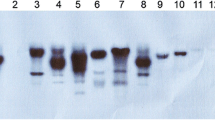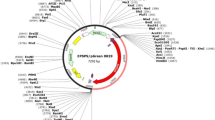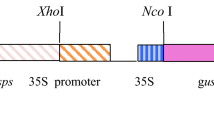Abstract
Key message
Highly tolerant herbicide-resistant transgenic rice was developed by expressing codon-modified synthetic CP4 - EPSPS . The transformants could tolerate up to 1 % commercial glyphosate and has the potential to be used for DSR (direct-seeded rice).
Abstract
Weed infestation is one of the major biotic stress factors that is responsible for yield loss in direct-seeded rice (DSR). Herbicide-resistant rice has potential to improve the efficiency of weed management under DSR. Hence, the popular indica rice cultivar IR64, was genetically modified using Agrobacterium-mediated transformation with a codon-optimized CP4-EPSPS (5-enolpyruvylshikimate-3-phosphate synthase) gene, with N-terminal chloroplast targeting peptide from Petunia hybrida. Integration of the transgenes in the selected rice plants was confirmed by Southern hybridization and expression by Northern and herbicide tolerance assays. Transgenic plants showed EPSPS enzyme activity even at high concentrations of glyphosate, compared to untransformed control plants. T 0, T 1 and T 2 lines were tested by herbicide bioassay and it was confirmed that the transgenic rice could tolerate up to 1 % of commercial Roundup, which is five times more in dose used to kill weeds under field condition. All together, the transgenic rice plants developed in the present study could be used efficiently to overcome weed menace.






Similar content being viewed by others
References
Berry G, Kishore G, Padgette S, Taylor M, Kolacz K, Weldon M, Re D, Eichholtz D, Fincher D, Hallas L (1992) Inhibitors of amino acid biosynthesis: strategies for imparting glyphosate tolerance to crop plants. In: Sinch BK, Flores HE, Shannon JC (eds) Biosynthesis and molecular regulation of amino acids in plants. American Society of Plant Physiologists, Rockville, pp 139–145
Bouman BAM, Lampayan RM, Tuong TP (2007) Water management in irrigated rice: coping with water scarcity. International Rice Research Institute, Los Baños
Carpenter JE (2010) Peer-reviewed surveys indicate positive impact of commercialized GM crops. Nat Biotechnol 28:319–321
Chandrasekhar K, Reddy GM, Singh J, Vani K, Vijayalakshmi M, Kaul T, Reddy MK (2014) Development of transgenic rice harbouring mutated rice 5-enolpyruvylshikimate 3-phosphate synthase (Os-mEPSPS) and Allium sativum Leaf Agglutinin (ASAL) genes conferring tolerance to herbicides and sap-sucking insects. Plant Mol Biol Rep 32:1146–1157
Charng YC, Li KT, Tai HK, Lin NS, Tu J (2008) An inducible transposon system to terminate the function of a selectable marker in transgenic plants. Mol Breeding 21:359–368
Comai LD, Facciotti D, Hiatt WR, Thompson G, Rose RE, Stalker DM (1985) Expression in plants of a mutant aroA gene from Salmonella typhimurium confers tolerance to glyphosate. Nature 317:741–744
De Rocher EJ, Vargo-Gogola TC, Diehn SH, Green PJ (1998) Direct evidence for rapid degradation of Bacillus thuringiensis toxin mRNA as a cause of poor expression in plants. Plant Physiol 117:1445–1461
Della-Cioppa G, Bauer SC, Klein BK, Shah DM, Fraley RT, Kishore GM (1986) Translocation of the precursor of 5-enolpyruvylshikimate 3-phosphate synthase into chloroplasts of higher plants in vitro. Proc Natl Acad Sci USA 83:6873–6877
Depicker A, Van Montagu M (1997) Post-transcriptional gene silencing in plants. Curr Opin Cell Biol 9:373–382
Farooq M, Siddique KHM, Rehman H, Aziz T, Lee D, Wahid A (2011) Rice direct seeding: experiences, challenges and opportunities. Soil Tillage Res 111:87–98
Funke T, Han H, Healy-Fried ML, Fischer M, Schönbrunn E (2006) Molecular basis for the herbicide resistance of roundup ready crops. Proc Natl Acad Sci USA 103:13010–13015
Gamborg OL, Murashige T, Thorpe TA, Vasil IK (1976) Plant tissue culture media. In Vitr Cell Dev Biol Plant 12:473–478
Hiei Y, Komari T (2008) Agrobacterium-mediated transformation of rice using immature embryos or calli induced from mature seed. Nat Protoc 3:824–834
Hobbs SLA, Warketin TD, Delong CMO (1993) Transgene copy number can be positively or negatively associated with transgene expression. Plant Mol Biol 21:17–26
Hofgen R, Willmitzer L (1988) Storage of competent cells for Agrobacterium transformation. Nucl Acids Res 16:9877
IRRI (International Rice Research Institute) (2006) Direct seeded rice: a low cost establishment technology. IRRI Rice factsheet. Available at http://www.narc.org.np/rice_knowledge_bank/factsheet/rice.pdf
James C (2013) Global status of commercialized biotech, GM crops: 2013. ISAAA Brief No 35. International Service for the Acquisition of Agri-Biotech Applications, Ithaca
Jorgensen RA, Cluster PD, English J, Que Q, Napoli CA (1996) Chalcone synthase co suppression phenotypes in petunia flowers: comparison of sense vs. antisense constructs and single-copy vs. complex T-DNA sequences. Plant Mol Biol 31:957–973
Joshi E, Kumar D, Lal B, Nepalia V, Gautam P, Vyas AK (2013) Management of direct seeded rice for enhanced resource-use efficiency. Plant Knowledge Journal 2:119–134
Kahrizi D, Salmanian AH, Afshari A, Moieni A, Mousavi A (2007) Simultaneous substitution of Gly96 to Ala and Ala183 to Thr in 5-enolpyruvylshikimate-3-phosphate synthase gene of E. coli (k12) and transformation of rapeseed (Brassica napus L.) in order to make tolerance to glyphosate. Plant Cell Rep 26:95–104
Kishore GM, Brundage L, Kolk K, Padgette SR, Rochester D, Huynh QK, Della-Cioppa G (1986) Isolation, purification and characterization of a glyphosate tolerant mutant E. coli EPSP synthase. Proc Fed Am Soc Exp Biol 45:1506
Kishore GM, Padgette SR, Fraley RT (1992) History of herbicide tolerant crops, methods of development and current state of the art-emphasis on glyphosate tolerance. Weed Technol 6:626–634
Kusnadi AR, Nikolov ZL, Howard JA (1997) Production of recombinant proteins in transgenic plants: practical considerations. Biotechnol Bioeng 56:473–484
Lanzetta PA, Alvarez LJ, Reinach PS, Candia OA (1979) An improved assay for nanomole amounts of inorganic phosphate. Anal Biochem 100:95–97
Maqbool SB, Christou P (1999) Multiple traits of agronomic importance in transgenic indica rice plants: analysis of transgene integration patterns, expression levels and stability. Mol Breeding 5:471–480
Murashige T, Skoog F (1962) A revised medium for rapid growth and bio-assays with tobacco tissue cultures. Physiol Plant 15:473–497
Murray EE, Lotzer J, Eberle M (1989) Codon usage in plant genes. Nucleic Acids Res 17:477–498
Murray EE, Rocheleau T, Eberle M, Stock C, Sekar V, Adang M (1991) Analysis of unstable RNA transcripts of insecticidal crystal protein genes of Bacillus thuringiensis in transgenic plants and electroporated protoplasts. Plant Mol Biol 16:1035–1050
Padgette SR, Re DB, Gasser CS, Eichholtz DA, Frazier RB, Hironaka CM, Levine EB, Shah DM, Fraley RT, Kishore GM (1991) Site-directed mutagenesis of a conserved region of the 5-enolpyruvylshikimic acid-3-phosphate synthase active site. J Biol Chem 266:22361–22369
Padgette SR, Re DB, Berry GF, Eichholtz DE, Delannay X, Fuchs RL, Kishore GM, Fraley RT (1996) New weed control opportunities: development of soybeans with a Roundup Ready gene. In: Duke SO (ed) Herbicide-resistant crops: agricultural, economic, environmental, regulatory and technological aspects. CRC Press, Boca Raton, pp 53–84
Perlak FJ, Fuchs RL, Dean DA, McPherson SL, Fischhoff DA (1991) Modification of the coding sequence enhances plant expression of insect control genes. Proc Natl Acad Sci USA 88:3324–3328
Porebski S, Bailey G, Baum BR (1997) Modification of a CTAB DNA extraction protocol for plants containing high polysaccharide and polyphenol components. Plant Mol Biol Rep 15:8–15
Quinn JP (1990) Evolving strategies for the genetic engineering of herbicide resistance in plants. Biotechnol Adv 8:321–333
Ray DK, Mueller ND, West PC, Foley JA (2013) Yield trends are insufficient to double total crop production by 2050. PLoS ONE. doi:10.1371/journal.pone.0066428
Reddy MS, Dinkins RD, Collins GB (2003) Gene silencing in transgenic soybean plants transformed via particle bombardment. Plant Cell Rep 21:676–683
Sambrook J, Russell DW (2001) Molecular cloning: a laboratory manual. Cold Spring Harbor Laboratory Press, New York
Singh S, Singh G, Singh VP, Singh AP (2005) Effect of establishment methods and weed management practices on weeds and rice in rice-wheat cropping system. Indian J Weed Sci 37:51–57
Stalker DM, Hiatt WR, Comai LD (1985) A single amino acid substitution in the enzyme 5-enolpyruvylshikimic acid-3-phosphate synthase confers resistance to herbicide glyphosate. J Biol Chem 260:4724–4728
Steinrücken HC, Amrhein N (1980) The herbicide glyphosate is a potent inhibitor of 5-enolpyruvyl-shikimic acid-3-phosphate synthase. Biochem Biophys Res Commun 94:1207–1212
Wada Y, Van Beek LPH, Van Kempen CM, Reckman JWTM, Vasak S, Bierkens MFP (2010) Global depletion of groundwater resources. Geophys Res Lett 37:L20402
Ye GN, Hajdukiewicz PT, Broyles D, Rodriguez D, Xu CW, Nehra N, Staub JM (2001) Plastid-expressed 5-enolpyruvylshikimate-3-phosphate synthase genes provide high level glyphosate tolerance in tobacco. Plant J 25:261–270
Zhao T, Lin CH, Shen ZC (2011) Development of transgenic glyphosate resistant rice with G6 gene encoding 5-enolpyruvylshikimate-3-phosphate synthase. Agr Sci China 10(9):1307–1312
Zhou H, Arrowsmith JW, Fromm ME, Hironaka CM, Taylor ML, Rodriguez D, Pajeau ME, Brown SM, Santino CG, Fry JE (1995) Glyphosate-tolerant CP4 and GOX genes as a selectable marker in wheat transformation. Plant Cell Rep 15:159–163
Zhou M, Xu H, Wei X, Ye Z, Wei L, Gong W, Wang Y, Zhu Z (2006) Identification of a glyphosate-resistant mutant of rice 5-enolpyruvylshikimate 3-phosphate synthase using a directed evolution strategy. Plant Physiol 140:184–195
Acknowledgments
We are grateful to Nuziveedu Seeds Limited (NSL), Hyderabad for providing financial assistance. We acknowledge the help of Dr Vikrant Nain for codon optimization of mCP4-EPSPS gene. We are also thankful to our colleagues Hari Kishore CM and Shruti Yadava for help.
Conflict of interest
The authors do not have any conflict of interest.
Author information
Authors and Affiliations
Corresponding author
Additional information
Communicated by Manoj Prasad.
Electronic supplementary material
Below is the link to the electronic supplementary material.

299_2014_1732_MOESM1_ESM.jpg
Supplementary Fig. 1: mCP4-EPSPS gene-specific PCR analysis of putative T 0 transgenic rice plant. M: 1-kb ladder, W: Water control; UC: Untransformed control plant; Lanes 1-15: Putative transgenic plants; PC: Binary plasmid control. (JPEG 13 kb)

299_2014_1732_MOESM2_ESM.jpg
Supplementary Fig. 2: Immunostrip analysis of T 0 CP4-EPSPS transgenic rice. UC; Untransformed control plant, Lane 1 to 15; T 0 putative transgenic plants (JPEG 44 kb)
Rights and permissions
About this article
Cite this article
Chhapekar, S., Raghavendrarao, S., Pavan, G. et al. Transgenic rice expressing a codon-modified synthetic CP4-EPSPS confers tolerance to broad-spectrum herbicide, glyphosate. Plant Cell Rep 34, 721–731 (2015). https://doi.org/10.1007/s00299-014-1732-2
Received:
Revised:
Accepted:
Published:
Issue Date:
DOI: https://doi.org/10.1007/s00299-014-1732-2




